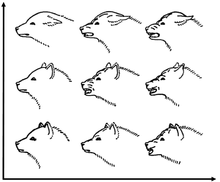Wolf communication
[2] Gray wolves howl to assemble the pack, usually before and after hunts, to pass on an alarm particularly at a den site, to locate each other during a storm or while crossing unfamiliar territory, and to communicate across great distances.
[6] The gray wolf's expressive behavior is more complex than that of the coyote and golden jackal, as necessitated by its group living and hunting habits.
[7][8] When neutral, the legs are not stiffened, the tail hangs down loosely, the face is smooth, the lips untensed, and the ears point in no particular direction.
[5] When a breeding male encounters a subordinate family member, it may stare at it, standing erect and still with the tail horizontal to its spine.
[12] When wolves are together, they commonly indulge in behaviors such as nose pushing, jaw wrestling, cheek rubbing and facial licking.
[13] Similar to humans, gray wolves have facial color patterns in which the gaze direction can be easily identified, although this is often not the case in other canid species.
[14] Gray wolves howl to assemble the pack (usually before and after hunts), to pass on an alarm (particularly at a den site), to locate each other during a storm or unfamiliar territory and to communicate across great distances.
[18] Howls used for calling pack mates to a kill are long, smooth sounds similar to the beginning of the cry of a great horned owl.
A combination of apocrine and eccrine sweat glands on the feet allows the wolf to deposit its scent whilst scratching the ground, which usually occurs after urine marking and defecation during the breeding season.
The follicles present on the guard hairs from the wolf's back have clusters of apocrine and sebaceous glands at their bases.
So-called raised leg urination (RLU) is more common in male wolves than in females, and may serve the purpose of maximizing the possibility of detection by conspecifics, as well as reflect the height of the marking wolf.
Only dominant wolves typically use RLU, with subordinate males continuing to use the juvenile standing posture throughout adulthood.




